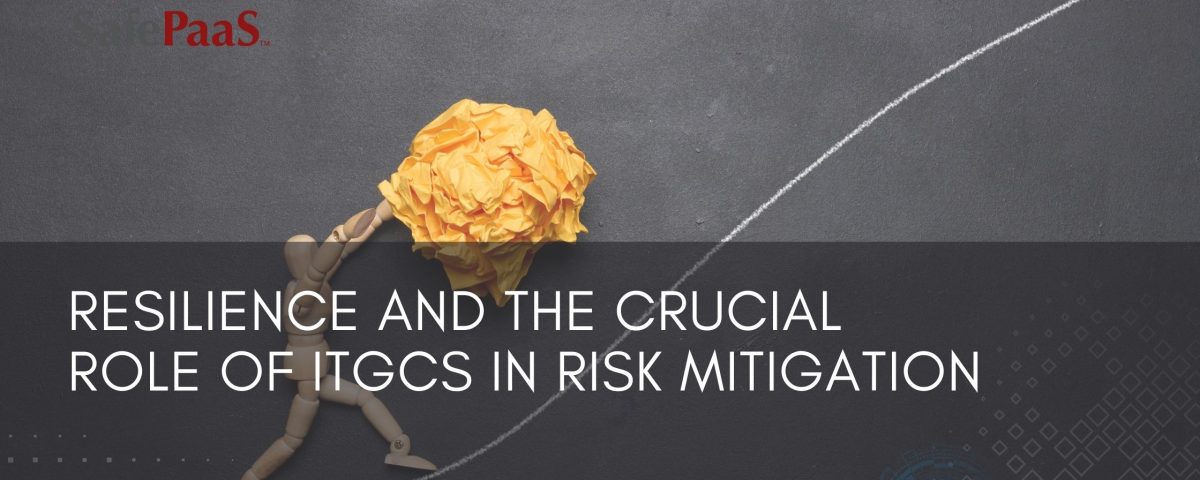The Crucial Role of ITGCs in Risk Mitigation


Resilience and the Crucial Role of ITGCs in Risk Mitigation
Insight from Industry experts Paul Haley (GRC and SOX Compliance Strategist),
HALEY Consulting and Advisory Services, and Adil Khan, SafePaaS, CEO.
In a volatile world, resilience is an increasingly critical prerequisite for performance. Effectively ensuring resilience is tied to adept risk mitigation practices, offering a strong shield against the uncertainties of the modern enterprise.
Even though SOX does not explicitly define Information Technology General Controls (ITGCs), these controls play a pivotal role in mitigating various risks, ranging from potential inaccuracies in financial reporting to safeguarding against security breaches.
The resilience and success of your organization are linked to your ability to manage the complexities of a dynamic environment; understanding the role of ITGCs and adopting a proactive approach to risk mitigation is vital for ensuring sustained success.
The Crucial Role of ITGCs in Risk Mitigation
ITGCs, or Information Technology General Controls, are key controls that ensure your organization's IT environment's reliability, integrity, and security. They encompass policies and procedures designed to safeguard data, manage access controls, and mitigate risks, playing a crucial role in maintaining the effectiveness and security of your organization's IT systems. Three of the most critical ITGCs are:
- Access Controls: Consider a scenario where a dormant ID can initiate and approve financial transactions. This lack of control could lead to severe repercussions, causing financial discrepancies and jeopardizing the integrity of reporting systems.
- Segregation of Duties and Sensitive Access Controls: Managing the complexities of maintaining access controls and segregation of duties in a dynamic digital landscape is like walking a tightrope. Striking the right balance becomes key for effective risk management, ensuring users have access without compromising security.
- Change Management Controls: Organizations grapple with unique challenges in managing ITGCs effectively in a digital era of constant change. Without proper change management controls, rapid changes in the IT environment directly threaten the integrity of financial reporting systems. A proactive approach involving continuous monitoring, automation, and preventive measures can fortify ITGCs against evolving risks.
5 Challenges in Managing ITGCs in a Digital Era
1. Rapid Technological Changes: The dynamic nature of technology introduces challenges in keeping ITGCs aligned with the ever-evolving IT landscape.
2. Complexities in Change Management: Implementing effective change management controls becomes challenging as organizations undergo frequent technological changes.
3. Cybersecurity Threats: Organizations face increased cybersecurity threats, requiring robust ITGCs to prevent unauthorized access and protect sensitive data.
4. Balancing Access and Security: Striking the right balance between granting necessary access and maintaining stringent security measures poses a continual challenge.
5. Continuous Monitoring: Ensuring continuous monitoring of ITGCs is crucial, but it can be challenging to implement due to the scale and complexity of digital environments.
Documenting Roles and Responsibilities in ERP Systems
Operational efficiency, transparency, and accountability hinge on effective role management and design. Organizations are tasked with creating, assigning, and maintaining roles within their ERP framework to define users' responsibilities and access levels based on their distinct job functions or roles.
Role design is a strategic process that creates and structures roles to align with your organizational requirements and security standards. The principle of least privilege guides this process, ensuring users have the minimum access required for their responsibilities. The inherent flexibility of role design allows customization for specific departments, teams, or individuals, catering to the unique needs of diverse organizational units.
Security is paramount in role design, requiring alignment with strict security policies to prevent data breaches and unauthorized actions. Well-designed roles contribute to effective auditing capabilities, enabling organizations to monitor and assess user activities for compliance and security objectives.
In digital transformation, navigating the complexities of organizational growth, technological advancements, and evolving corporate structures is critical. As businesses expand, challenges occur from changes in roles, responsibilities, workflows, and technology upgrades. Managing the complexities presented by changes in organizational growth, technological changes, and evolving corporate structures is essential for digital transformation.
Addressing these challenges requires proactive strategies to maintain IT governance and effective access control. Organizations that employ these best practices are better positioned to mitigate risks, enable efficiency, and be resilient.
Aligning ERP Roles with Security Policies
- Role Design Best Practices: Organizations should follow role design best practices, such as the principle of least privilege, to align ERP roles with security policies.
- Flexibility and Customization: ERP role design should be inherently flexible, allowing customization for different organizational units while adhering to overall security and compliance standards.
- Security Integration: Integrating security policies directly into role design ensures that roles are created with security considerations from the outset.
- Regular Audits: Regular audits of ERP roles help verify alignment with security policies and identify and rectify any discrepancies.
- User Training and Awareness: Educating users about security policies and their role in maintaining security helps ensure that they understand and adhere to guidelines.
Access Governance to the Rescue
An Access Governance platform with robust role management capabilities is key in addressing the challenges associated with risk mitigation, operational efficiency, and managing organizational structure and technology changes. Let's delve into how such a platform can effectively solve these challenges:
ITGC Risk Mitigation
- Access Controls: The platform enforces and manages access controls, ensuring users have the appropriate permissions based on their roles. This helps prevent unauthorized access, reducing the risk of financial inaccuracies or fraudulent activities.
- Segregation of Duties and Sensitive Access: The platform facilitates the definition and enforcement of segregation of duties (SoD) policies, preventing conflicts that could lead to financial discrepancies. It also manages sensitive access, ensuring critical functions are restricted to authorized personnel.
- Change Management: A comprehensive Access Governance platform includes change management controls and tracks and manages alterations in the IT environment. This prevents the introduction of errors or vulnerabilities that could compromise the integrity of financial reporting systems.
- Continuous Monitoring and Automation: The platform supports continuous monitoring and automation, allowing organizations to proactively detect and rectify unauthorized access. Automation enhances the preventive aspects of ITGCs, making the organization more resilient to evolving risks.
Secure Roles Management
- Efficient Role Design: The platform assists in the strategic process of role design within ERP systems. It ensures that roles are efficiently structured to align with organizational requirements and security standards. The principle of least privilege is applied, granting users the minimum access necessary for their responsibilities.
- Flexibility and Customization: Role design is inherently flexible, allowing customization for specific departments, teams, or individuals. This ensures that roles can be tailored to meet the unique needs of diverse units while maintaining security and compliance.
- Security and Auditing: Access Governance platforms emphasize security in role design, aligning with strict security policies to prevent data breaches and unauthorized actions. Well-designed roles contribute to effective auditing capabilities, enabling organizations to monitor and assess user activities for compliance and security objectives.
- Adaptability to Changes: The platform supports an adaptable ERP environment by facilitating efficient role management. When organizational changes occur, such as shifts in roles or responsibilities, the platform ensures that role assignments are promptly adjusted, reducing the risks associated with outdated access privileges.
An Access Governance platform with secure role management capabilities is a centralized solution that streamlines access control, role design, and compliance. It allows your organization to proactively manage risks, enhance operational efficiency, and adapt to the dynamic nature of modern business environments.
8 Features of an Effective Access Governance Platform:
1. Access Controls Enforcement: Enforce and manage access controls to ensure users have appropriate permissions based on their roles.
2. Segregation of Duties (SoD) Management: Comprehensive management of Segregation of Duties policies to prevent conflicts and potential financial discrepancies.
3. Change Management Controls: Ability to track, manage, and mitigate changes in the IT environment.
4. Continuous Monitoring and Automation: Proactively detect and rectify unauthorized access, enhancing preventive aspects of ITGCs.
5. Role Design Simulation: Ensures alignment with organizational requirements and security standards.
6. Flexibility and Customization: Flexibility for customization, allowing tailored roles for specific departments or regions while maintaining security.
7. Security and Auditing Emphasis: Emphasis on security in role design, aligning with strict security policies to prevent data breaches and unauthorized actions.
8. Adaptability to Changes: Support for an adaptable ERP environment by facilitating efficient role management and quickly adjusting role assignments during organizational changes to reduce risks associated with outdated access privileges.
The importance of resilience in the face of a volatile business landscape cannot be overstated, and ITGCs play a pivotal role in mitigating risks, safeguarding financial reporting integrity, and protecting against security breaches.
Understanding and adopting a proactive approach to risk mitigation, particularly in managing the challenges presented by rapid technological changes, complexities in change management, and security threats, is essential for your organizational success.
By aligning ERP roles with security policies and leveraging robust Access Governance platforms, you can fortify IT governance, proactively address risks, and enhance operational efficiency. Elevate your IT governance today to ensure resilience and mitigate ITGC risks effectively.
Are you ready to fortify your organization against ITGC risks?
Recommended Resources

Everything you need to know about ITGC SOX
If your ITGCs are insufficient it can lead to disclosures to investors if your ITGCs are cited in your financial audit. You also risk losing business if poor ITGCs scare potential customers who are concerned about security risks. Disclosures and poor security will also lead to costly remediation.

A quick Guide - SOX Compliance Audit
A SOX control is a rule that prevents and detects errors within a process of financial reporting. The purpose of these controls is to ensure accurate and reliable financial reporting.

Solving the High Costs of SOX Audits
The key to maximizing SOX audit efficiency is leveraging technology to automate manual enterprise-wide processes. The survey indicates a growing number of companies are leveraging technology and automation to support SOX compliance efforts using platforms and applications to bring greater efficiency to SOX compliance activities.

